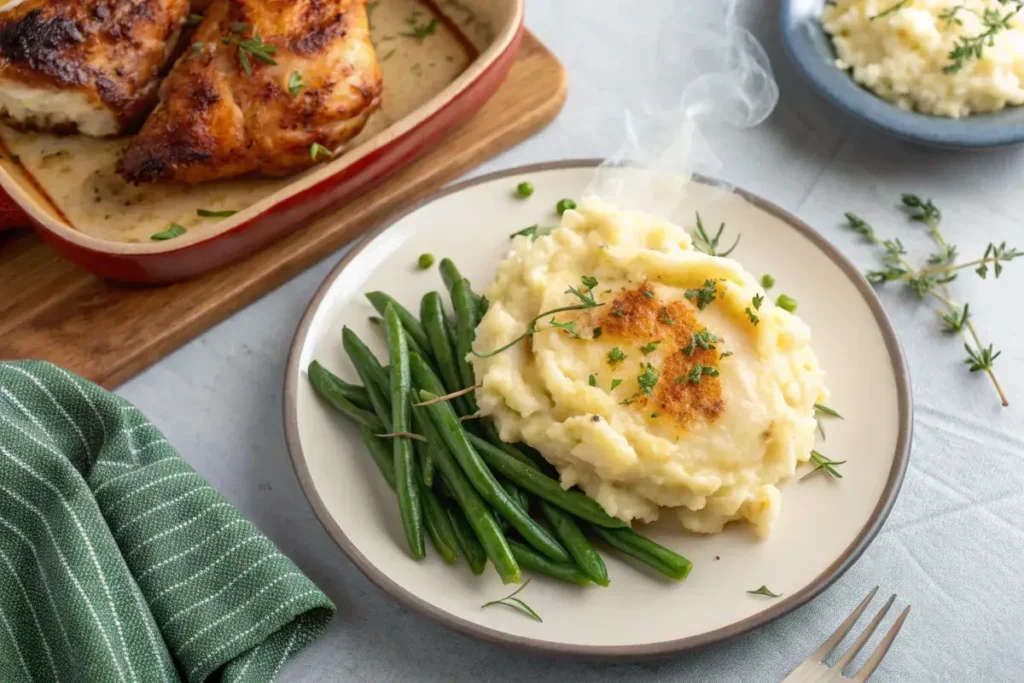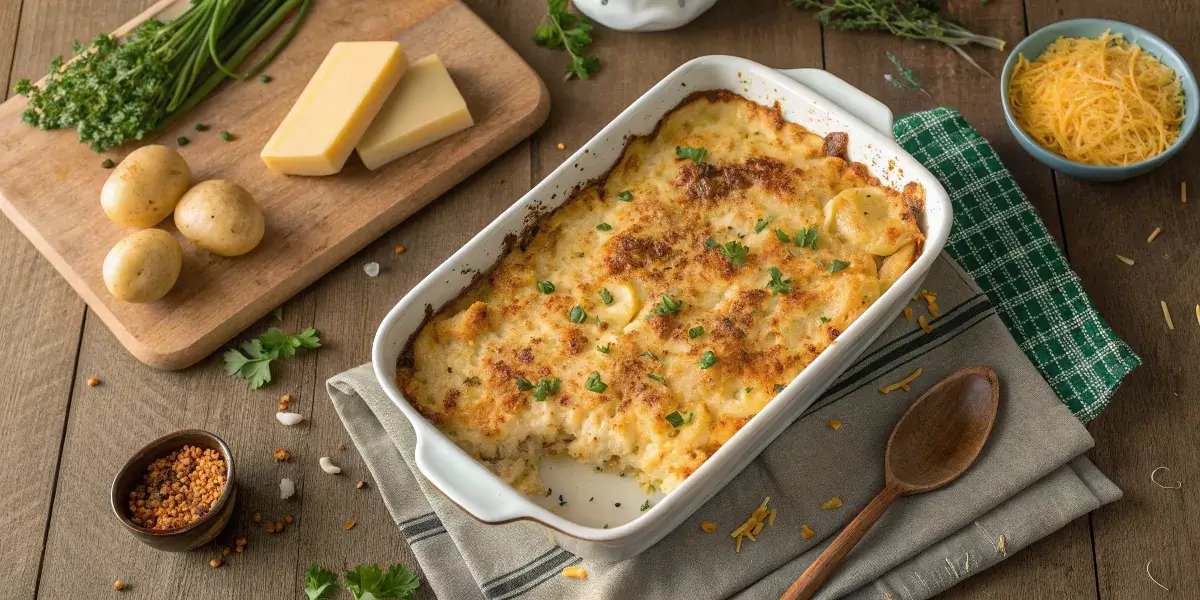Looking for the perfect dish that’s comforting, creamy, and guaranteed to win over a crowd? Look no further than this mashed potato casserole. Whether you’re prepping for a holiday dinner, a cozy Sunday meal, or just want to upgrade your usual mashed potatoes, this casserole takes things up a notch.
In this guide, you’ll discover what makes mashed potato casserole a family favorite, learn about must-have ingredients and tasty add-ins, and pick up pro tips on how to prep, bake, and store it. We’ll also answer some of the most common questions people have—like whether to add eggs, which potatoes work best, and why soaking potatoes matters.
Let’s dig into the creamy, cheesy goodness.
Why Mashed Potato Casserole Is a Family Favorite
Comfort Food with a Twist
At its core, mashed potato casserole is the ultimate comfort food. It’s rich, buttery, and indulgent—but also incredibly easy to make. By baking mashed potatoes in a casserole dish with cheese and toppings, you create a side dish that’s cozy yet elevated. It’s a fantastic way to turn plain old mashed potatoes into something decadent and memorable.
When to Serve It
This dish shines during the holidays, but it’s just as perfect for casual gatherings or even weekday dinners. You can make it ahead, freeze it, or dress it up with bacon, herbs, or garlic for special occasions. It’s flexible, filling, and always a hit.
Ingredients for the Best Mashed Potato Casserole
Must-Have Ingredients
To create the ultimate mashed potato casserole, you’ll need a few pantry staples and rich add-ins. The base starts with starchy Yukon Gold or Russet potatoes—perfect for a fluffy, smooth mash. Add butter, sour cream, cream cheese, and milk to elevate the texture. Don’t forget shredded cheddar cheese, salt, pepper, and a dash of garlic powder for flavor.

Optional Add-Ins
To level up your casserole, try adding crisp bacon bits, chopped green onions, or a sprinkle of Parmesan. Love a golden crust? Toss some buttery breadcrumbs or extra cheese on top. If you like this kind of baked side, you might also enjoy this cheesy potato casserole recipe for more hearty inspiration.
Step-by-Step Cooking Method
How to Prepare Mashed Potatoes for the Casserole
Start by peeling and cutting your potatoes into chunks. Boil them in salted water until fork-tender—usually 15–20 minutes. Drain well and return to the pot. Mash while still hot, then fold in your butter, cream cheese, and sour cream. For a silkier texture, add a splash of warm milk or cream. Mix until smooth and creamy, but avoid overworking the potatoes.
Baking and Topping
Preheat your oven to 375°F (190°C). Spread the mashed mixture into a buttered casserole dish. Sprinkle a generous layer of shredded cheese over the top—or add bacon bits and chives for extra kick. Bake uncovered for about 25–30 minutes, or until the top is golden and bubbly.
This mashed potato casserole reheats beautifully and is perfect for prepping ahead. It’s a total game-changer for holiday spreads or weeknight dinners. Pair it with roasted chicken or grilled veggies for a balanced meal.

Pro Tips and Substitutions
Make It Ahead or Freeze It
One reason mashed potato casserole is so popular? It’s incredibly flexible! You can prep it the night before, store it in the fridge, and simply bake before serving. If you’re planning even further ahead, freeze the assembled dish (unbaked) in a foil-lined tray. When you’re ready, defrost overnight in the fridge and pop it in the oven.
Lighter Options
Want to lighten things up? Use Greek yogurt instead of sour cream or opt for low-fat cheese. Swapping in cauliflower mash for half the potatoes is a clever trick too. It cuts carbs while keeping the creamy, dreamy texture.
Storage and Reheating Tips for Mashed Potato Casserole
How to Store and Keep It Fresh
Leftovers of your mashed potato casserole can be stored in an airtight container in the fridge for up to 4 days. Make sure the dish cools to room temperature before sealing. This keeps the texture smooth and avoids sogginess.
Reheating Without Drying Out
To reheat, place the casserole in a covered baking dish at 350°F for about 20 minutes. You can add a splash of milk or cream before baking to restore moisture. Microwaving works too—just cover it and heat in 1-minute intervals to avoid drying out.
FAQs – People Also Ask
What does Gordon Ramsay put in his mashed potatoes?
Chef Ramsay’s signature mashed potatoes use Yukon Golds, loads of butter, crème fraîche, and a touch of garlic. These elevate the flavor and make them smooth and silky—perfect for a luxurious mashed potato casserole.
What does adding an egg to mashed potatoes do?
Adding an egg helps bind the mash, especially when baking it as a casserole. It gives structure and richness without altering the classic flavor. Just beat it in while the mash is warm but not hot, to avoid scrambling.
Why do you soak potatoes in cold water for mashed potatoes?
Soaking peeled, chopped potatoes in cold water draws out excess starch. This simple trick helps you get a lighter, fluffier mash—ideal as a base for your baked mashed potato casserole.
Which potatoes are best for casseroles?
Go with Yukon Gold or Russet potatoes. They’re starchy and break down nicely for a creamy result. Waxy potatoes, like reds, are better for salads—not casseroles.
For more delicious comfort dishes, check out our sausage breakfast casserole recipe.
Conclusion
There’s no doubt that mashed potato casserole is a comforting, crowd-pleasing classic. Whether you’re prepping it ahead for the holidays or whipping it up for a weeknight side, this dish delivers every time. It’s creamy, cheesy, and completely customizable—what’s not to love?

Plus, with tips for storage, healthy swaps, and even make-ahead tricks, it’s never been easier to enjoy. Now that you know how to perfect it, why not give this casserole a spot at your next dinner table?
For more delicious creamy soup inspiration, check out other casserole recipes. Happy baking!

